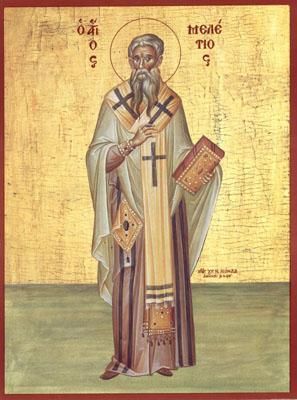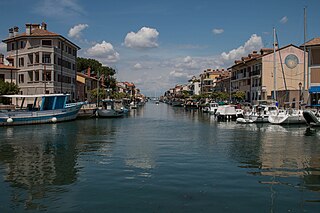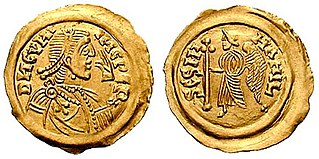Related Research Articles

Aquileia is an ancient Roman city in Italy, at the head of the Adriatic at the edge of the lagoons, about 10 kilometres (6 mi) from the sea, on the river Natiso, the course of which has changed somewhat since Roman times. Today, the city is small, but it was large and prominent in classical antiquity as one of the world's largest cities with a population of 100,000 in the 2nd century AD and is one of the main archaeological sites of northern Italy. In late antiquity the city was the first city in the Italian Peninsula to be sacked by Attila the Hun.

Saint Meletius was a Christian bishop of Antioch from 360 until his death in 381. He was opposed by a rival bishop named Paulinus and his episcopate was dominated by the schism, usually called the Meletian schism. As a result, he was exiled from Antioch in 361–362, 365–366 and 371–378. One of his last acts was to preside over the First Council of Constantinople in 381.
Pope John XIX, born Romanus, was the bishop of Rome and ruler of the Papal States from 1024 to his death. He belonged to the family of the powerful counts of Tusculum, succeeding his brother, Benedict VIII. Papal relations with the Patriarchate of Constantinople soured during John XIX's pontificate. He was a supporter of Emperor Conrad II and patron of the musician Guido of Arezzo.
The Schism of the Three Chapters was a schism that affected Chalcedonian Christianity in Northern Italy lasting from 553 to 698 AD and in some areas to 715 AD, although the area out of communion with Rome contracted during that time. It was part of a larger Three-Chapter Controversy that affected the whole of Roman-Byzantine Christianity.
The Three-Chapter Controversy, a phase in the Chalcedonian controversy, was an attempt to reconcile the non-Chalcedonians of Syria and Egypt with Chalcedonian Christianity, following the failure of the Henotikon. The Three Chapters that Emperor Justinian I anathematized were:
- The person and writings of Theodore of Mopsuestia
- Certain writings of Theodoret of Cyrus
- The letter of Ibas of Edessa to Maris
In the history of Christianity and later of the Roman Catholic Church, there have been several Councils of Aquileia. The Roman city of Aquileia at the head of the Adriatic is the seat of an ancient episcopal see, seat of the Patriarch of Aquileia.

The Patriarch of Venice is the ordinary bishop of the Archdiocese of Venice. The bishop is one of only four patriarchs in the Latin Church of the Catholic Church. The other three are the Patriarch of Lisbon, the Patriarch of the East Indies and the Latin Patriarch of Jerusalem. Presently, the only advantage of this purely formal title is the bishop's place of honor in papal processions. In the case of Venice, an additional privilege allows the patriarch, even if he is not a cardinal, the use of the colour red in non-liturgical vestments. In that case, the red biretta is topped by a tuft, as is the custom with other bishops who are not cardinals.

Grado is a town and comune of 8,064 residents in the north-eastern Italian region of Friuli-Venezia Giulia, located on an island and adjacent peninsula of the Adriatic Sea between Venice and Trieste. The territory of the municipality of Grado extends between the mouth of the Isonzo and the Adriatic Sea and the Grado Lagoon, and covers an area of about 90 square kilometers between Porto Buso and Fossalon. Characteristic of the lagoon is the presence of the casoni, which are simple houses with thatched roof used in the past by the fishermen of Grado, who remained in the lagoon for a long time, returning to the island of Grado only during the colder period of the year.

This is a list of the Patriarchs of Grado.

Cunipert was king of the Lombards from 688 to 700. He succeeded his father Perctarit, though he was associated with the throne from 680.

The Patriarchate of Aquileia was an episcopal see in northeastern Italy, centred on the ancient city of Aquileia situated at the head of the Adriatic, on what is now the Italian seacoast. For many centuries it played an important part in history, particularly in that of the Holy See and northern Italy, and a number of church councils were held there.
The Aquileian Rite was a particular liturgical tradition of the Patriarchate of Aquileia and hence called the ritus patriarchinus. It was effectively replaced by the Roman Rite by the beginning of the seventeenth century, although elements of it survived in St. Mark's Basilica in Venice until 1807.

Saint Paulinus II was a priest, theologian, poet, and one of the most eminent scholars of the Carolingian Renaissance. From 787 to his death, he was the Patriarch of Aquileia. He participated in a number of synods which opposed Spanish Adoptionism and promoted both reforms and the adoption of the Filioque into the Nicene Creed. In addition, Paulinus arranged for the peaceful Christianisation of the Avars and the alpine Slavs in the territory of the Aquileian patriarchate. For this, he is also known as the apostle of the Slovenes.
Poppo of Treffen was the fifty-seventh patriarch of Aquileia from 1019 to 1045.
The Synod of Grado was a Synod held in 579 by bishops loyal to the Patriarch of Aquileia. It was held in Grado as the Patriarch had fled there after the Lombard invasion of Northern Italy. The Synod helped to prolong the schism of the Three Chapters.
The Patriarchate of Old Aquileia existed between 607 and 698 because of the Tricapitoline Schism in the Patriarchate of Aquileia. It was allied with the Arian Lombards, while the rival Patriarchate of Grado was allied with the Byzantine Empire.
Maxentius of Aquileia was an Italian Patriarch. Maxentius served as the Patriarch of Aquileia from 811 until his death in 837.
Enrico Dandolo was Patriarch of Grado, Italy, from 1134 to 1182. A member of a noble Venetian Dandolo family, after his appointment he put the interests of the church ahead of all other concerns.

Ulrich II von Treven was Patriarch of Aquileia in northern Italy from 1161 to 1181. He supported Frederick I, Holy Roman Emperor, (1122–1190) in his unsuccessful struggle for supremacy over the northern Italian states and the papacy. He was also involved in a dispute over jurisdiction with the Patriarch of Grado where he was ultimately successful.
References
- ↑ Jeffrey Richards, The Popes and the Papacy in the Early Middle Ages (London:Routledge and Kegan Paul, 1979), p. 37